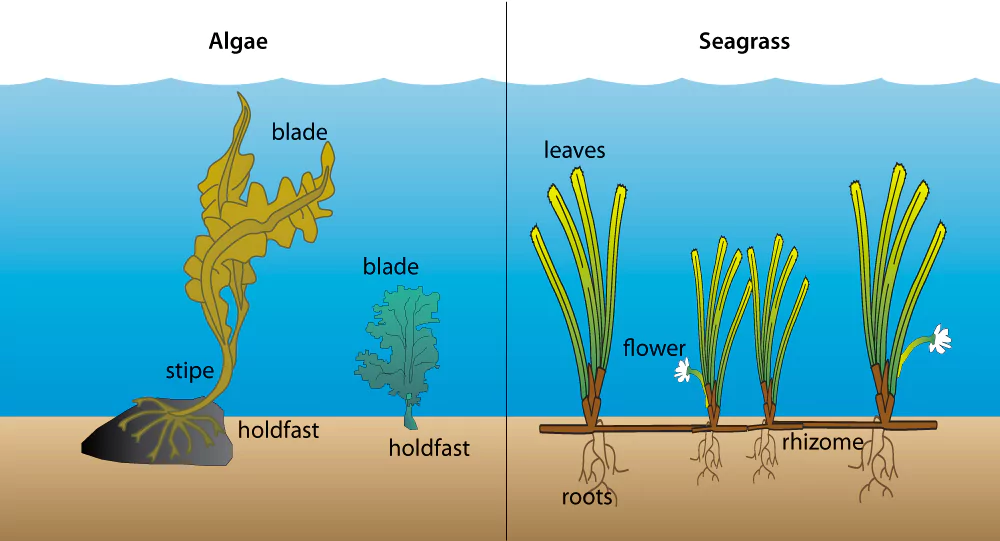Context:
The National Conference on Promotion of Seaweed Cultivation was chaired by the Union Minister of Fisheries, Animal Husbandry & Dairying at Koteshwar (Kori Creek), Kutch, Gujarat.
Seaweed Cultivation in India
- The Pilot was conducted at the Koteshwar (Kori Creek), Kutch, Gujarat where diverse methods of seaweed cultivation viz. Monoline, tube-net and rafts were demonstrated by CMFRI, CSMCRI and NFDB during the National Conference on Seaweed Development.

About Seaweeds
- Seaweeds are a form of macroscopic algae, a primitive type of plant lacking true roots, stems and leavesHabitat: They grow in the marine and shallow coastal waters or brackish water habitats and on rocky shores.
- Types: seaweeds are recognized into Four groups according to their pigments that absorb light of particular wavelengths.
Seagrasses:
- Seagrass is a marine vascular plant flowering plant which is a true vascular plant.
- It has true stems, roots and leaves. Furthermore, seagrass produces fruits and seeds, unlike seaweeds.
|
-
- These are Chlorophyta (green algae), Phaeophyta (brown algae) and Rhodophyta (red algae) and Blue algae.
- India possesses around 434 species of Red Algae, 194 species of Brown Algae, and 216 species of Green Algae.
- In India: Around 844 species of seaweeds have been reported from Indian seas primarily found along the coast of Tamil Nadu and Gujarat and around Lakshadweep and Andaman & Nicobar Islands.
Application of Seaweed
- Renewable source of Food, energy, chemicals and medicines with manifold nutritional, industrial, biomedical, agriculture and personal care applications.
- Pharmaceutical Industry: They are used as laxatives, for making pharmaceutical capsules, in the treatment of goitre cancer, in bone-replacement therapy and in cardiovascular surgeries.
- Industrial: They are a source of Agar, Alginates and Carrageenan used in laboratories, pharmaceuticals, cosmetics, cardboard, paper, paint and processed foods.
- Environmental Benefits: Seaweeds are incredibly efficient at sucking up carbon dioxide and using it to grow.
- For Example: Eelgrass, mangroves, and salt marshes are known for their ability to store carbon.
- Bioplastic: The National Institute of Ocean Technology (NIOT) has developed a bioplastic film using marine seaweed and PEG-3000 which could have a huge impact on limiting the usage of non-biodegradable plastics and a game-changer in the plastic industry
Seaweed Cultivation in India: Status, Importance and Challenges
- In 2022, the global production of seaweed was close to 35 million tonnes worth about $16.5 billion. In comparison, India only had a production of 34,000 tonnes.
- The Indian government has created a package of Rs 640 crore to promote seaweed cultivation of up to 1.12 million tonnes by 2025.
- India has the potential to produce around 9.7 million tonnes of seaweed per year, according to the Central Marine Fisheries Research Institute.
-
Importance of Seaweed Cultivation
-
- Additional income source: It provides occupation and source of income for the coastal people.
- Address scarcity concerns: Provide a continuous supply of raw materials for seaweed-based industry.
- Conservation efforts: Conserve natural populations of concerned seaweeds.
- Eco-friendly: Seaweed cultivation is a major tool to treat coastal pollution in the sea and reduce CO2
-
Challenges in Cultivation
- Overexploitation of sea beds: leading to a scarcity of raw material, poor quality raw material
- Manpower unavailability: labour shortages during the paddy harvesting season
- Technological backwardness: lack of technology to improve processed product quality
- Information deficit: lack of information on new and alternative sources of raw materials.
Also Read: Harnessing The Potential Of Fisheries Sector
News Source: PIB

